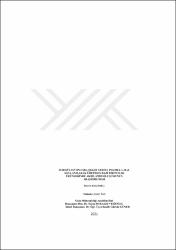| dc.contributor.advisor | Velioğlu, Serap Duraklı | |
| dc.contributor.advisor | Güner, Kadir Gürbüz | |
| dc.contributor.author | Kazancı, Merve | |
| dc.date.accessioned | 2022-04-06T06:49:33Z | |
| dc.date.available | 2022-04-06T06:49:33Z | |
| dc.date.issued | 2021 | |
| dc.identifier.uri | https://tez.yok.gov.tr/UlusalTezMerkezi/TezGoster?key=8tbPippmWV_b-Irrn9YEApiZ-5VyaNAy_iG1fdJIpGsA5lzbDu6spz2rN58qja7F | |
| dc.identifier.uri | https://hdl.handle.net/20.500.11776/4172 | |
| dc.description.abstract | Bu çalışma ile formülasyonunda şeker yerine pekmez veya bal kullanılarak üretilen kek ve kurabiye ürünlerinde akrilamid oluşumu araştırılmıştır. Akrilamid analizinin yanı sıra üretilen kek ve kurabiye ürünlerinde pH, kuru madde, su aktivitesi, tekstür, şeker, ağırlık kaybı, kabarma indeksi ve renk analizleri yapılmıştır. Ayrıca örnek hamurlarında pH, su aktivitesi ve renk analizleri gerçekleştirilmiştir. Kek ve kurabiye örneklerindeki akrilamid konsantrasyonu LC-MS/MS yöntemiyle belirlenmiştir. Kontrol grubunda akrilamid miktarı tespit limiti altında kalırken, formülasyondaki pekmez oranının artmasıyla akrilamid miktarında artış tespit edilmiştir. Kek örneklerinde pekmez oranının artmasıyla akrilamid miktarları 141,36±4,21 ng/g, 162,82±3,63 ng/g ve 195,67±0,85 ng/g olarak saptanmıştır. Ballı kek örneklerinde ise akrilamid miktarı tespit limitinin altında kalmıştır. Kurabiye örneklerinin akrilamid analizi sonucunda, formülasyondaki pekmez veya balın artmasıyla akrilamid miktarının da arttığı tespit edilmiştir. Kurabiye kontrol grubunda, akrilamid miktarı 30,97±4,68 ng/g olarak tespit edilirken, pekmez miktarının artmasıyla akrilamid miktarları 824,3±27,47 ng/g, 1274,04±7,59 ng/g ve 1468,32±55,48 ng/g olarak saptanmıştır. Formülasyondaki bal oranının artışıyla birlikte akrilamid miktarları 374,25±19,37 ng/g, 495,63±2,89 ng/g ve 598,63±12,95 ng/g olarak bulunmuştur. Formülasyondaki şekerin %100'ünün pekmez ile ikame edilmesiyle üretilen kurabiye örneğinde en yüksek akrilamid miktarı tespit edilmiştir. Sonuç olarak, kek ve kurabiye gibi fırıncılık ürünlerinde, rafine şeker tüketimini azaltmak amacıyla, bu ürünlere pekmez veya bal ilave edilmesinin, bu ürünlerdeki akrilamid miktarını önemli düzeylerde artırabileceği tespit edilmiştir. Rafine şeker tüketimini azaltmak amacıyla yapılan buna benzer uygulamalar, bu ürünleri sıklıkla tüketen kişilerin toksik bir bileşik olan akrilamide maruziyetini artırabilir. | en_US |
| dc.description.abstract | In this study, the formation of acrylamide in cake and cookie products produced using molasses or honey instead of sugar was investigated. In addition to the acrylamide analysis, pH, dry matter, water activity, texture, sugar, weight loss, swelling index and color analyzes were performed in the cake and cookie products produced. In addition, pH, water activity and color analysis of sample doughs were carried out. Acrylamide concentration in cake and cookie samples was determined by LC-MS/MS method. The amount of acrylamide in the control group remained below the limit of detection. It was determined that the amount of acrylamide increased with the increase of molasses in the formulation. Acrylamide amounts were determined 141.36±4.21 ng/g, 162.82±3.63 ng/g and 195.67±0.85 ng/g, with the increase of molasses in cake samples. In honey cake samples, the amount of acrylamide was below the detection limit. As a result of the acrylamide analysis of the cookie samples, it was determined that the amount of acrylamide increased with the increase of molasses or honey in the formulation. While the amount of acrylamide was determined 30.97±4.68 ng/g in the cookie control group, with the increase in the amount of molasses, the amount of acrylamide was detected 824.3±27.47 ng/g, 1274.04±7.59 ng/g and 1468.32±55.48 ng/g. The acrylamide amounts were determined 374.25±19.37 ng/g, 495.63±2.89 ng/g and 598.63±12.95 ng/g, with the increase in the amount of honey in the formulation. The highest amount of acrylamide was found in the cookie sample produced by replacing 100% of the sugar in the formulation with molasses. As a result, it has been determined that adding molasses or honey to these products in order to reduce the amount of refined sugar intake in bakery products such as cakes and cookies can significantly increase the amount of acrylamide in these products. Similar practices made to reduce refined sugar intake can increase the exposure of people who consume these products frequently to acrylamide, a toxic compound. | en_US |
| dc.language.iso | tur | en_US |
| dc.publisher | Tekirdağ Namık Kemal Üniversitesi | en_US |
| dc.rights | info:eu-repo/semantics/openAccess | en_US |
| dc.subject | Gıda Mühendisliği | en_US |
| dc.subject | Food Engineering | en_US |
| dc.title | Formülasyonunda şeker yerine pekmez ve bal kullanılarak üretilen bazı fırıncılık ürünlerinde akrilamid oluşumunun araştırılması | en_US |
| dc.title.alternative | Investigation of acrylamide formation in some bakery products produced using pekmez and honey as sugar substitutes in their formulation | en_US |
| dc.type | masterThesis | en_US |
| dc.department | Enstitüler, Fen Bilimleri Enstitüsü, Gıda Mühendisliği Ana Bilim Dalı | en_US |
| dc.identifier.startpage | 1 | en_US |
| dc.identifier.endpage | 117 | en_US |
| dc.institutionauthor | Kazancı, Merve | |
| dc.relation.publicationcategory | Tez | en_US |
| dc.identifier.yoktezid | 671407 | en_US |



















